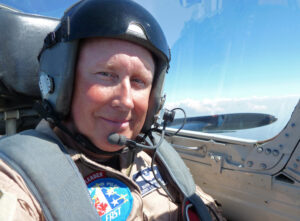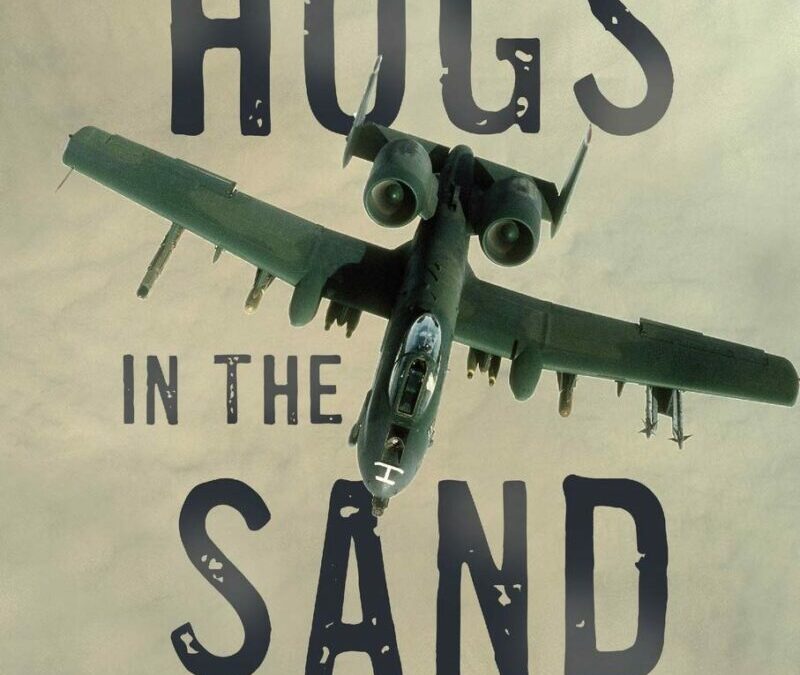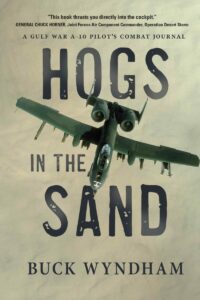
Buck Wyndham graduated from college and joined the Air Force to fly his dream airplane, the A-10 Thunderbolt II also called the “Warthog.” He became one of the very first pilots to take the mighty Warthog into battle, flying numerous missions during Operation Desert Storm. He went on to fly the T-38 Talon as an instructor, training new Air Force pilots. He is currently a captain for a major US airline, and also continues to fly privately-owned, surplus military jets as a test pilot and instructor. Buck has written articles for Warbirds, Classic Jet Journal, and Warbird Digest. A skilled photographer and videographer, he enjoys vintage aircraft, studying history, 3D printing, collecting tools, driving his rail speeder, and exploring ghost towns. He is working on his next book, a novel entitled Red Air.
“I am awed by my destructive power. With a small squeeze of the gun trigger under my right index finger, I can rip the turret off a thirty-ton battle tank and throw it 200 feet across the desert, while the rest of the tank burns in an explosion of white-hot, burning phosphorescence. But the cold, morbid reality of it does not exist from where I sit and watch it happen. There’s no dramatic chord. No deafening explosion. No screams suddenly stifled. The soundtrack of a pilot’s war is mostly silent.”
The mighty, iconic A-10 Warthog was first thrust into battle in Operation Desert Storm. The men who took it through walls of flak and surface-to-air missiles to help defeat the world’s fourth-largest army were as untested as their airplanes, so they relied on personal determination and the amazing A-10 to accomplish their missions, despite the odds.
Hogs in the Sand is the gripping journey of one of those pilots as he fights an increasingly terrifying war, all the while attempting to win over a woman and keep control of his internal demons. For anyone who has admired the Warthog, seen it in action, or called upon it to be their salvation, this story will fulfill a desire to virtually strap into the cockpit, while gaining unprecedented understanding of the mind of a modern combat pilot.
- What inspired you to write your book, Hogs in the Sand? What was the process like to write it?
Answer: Sometimes, a book just screams to be written. In my case, I knew, from the moment I was notified that my Air Force squadron would be going to war, that I had a personal duty to document what was to come, in as much detail as I could muster. So my book began as a daily journal I kept for nearly a year as we trained and prepared ourselves, deployed to the Middle East, and finally took our untested airplanes into battle. During the war, I wrote for at least an hour each evening, attempting to chronicle not only the events of each day of combat, but my challenges, joys, and deep fears. I tried to be as “literary” as I could, despite being in such a disadvantageous place, under such difficult circumstances. But when the war was over, I knew in my heart that the journal was not really suitable for publication as-is. There was a lot of good material there, but it took many years of reflection and enthusiastic procrastination before I was able to craft the journal into a manuscript with a narrative story arc and a style that would appeal to a general audience. It was a roundabout way to write a book, for sure.
2. As a writer, what is the greatest challenge you face?
Answer: As a stereotypical, steely-eyed fighter pilot who existed in a world of machismo, ego, and carefully-controlled personal image, baring my soul completely through my writing was something I wrestled with. It’s just not something that’s done very much in the fighter pilot community. As I crafted the book, questions swirled in my mind: How much of my inner self should I share without appearing “weak”? How much humor is necessary to keep a war story from getting too grim and self-indulgent? How do I bring the reader along for the ride without overwhelming them with every detail? How do I protect the privacy and personal security of my fellow pilot-buddies who are a big part of the story but might not want their identities and experiences shared with the world? These questions ruled my thoughts as I whittled my journal from 800 pages down to 400. In the end, I think I was able to strike a good balance, and, in the process, I gradually let go of the fear of baring my soul. Nowadays, I actually try to emphasize emotion in my writing rather than mask it or stifle it. But I still have to constantly focus on dropping the walls around my psyche.
3. Where (or when) do you find yourself most inspired to create?
Answer: My life involves a lot of flying, and that activity is the single greatest influence and motivator for me. Flying provides me with both freedom and the sight of vast skyscapes of such extraordinary beauty that I am constantly presented with grand inspiration for stories, thoughts, and photography. But any outdoor location, surrounded by nature, can be a writing catalyst for me. Sometimes, I also use ambient or classical music to fully immerse myself in the writing process. Unfortunately, I usually cannot write at the same time I’m enjoying an aerial vista, because I’m usually at the controls of an airplane. So when I’m inspired in that way, I have to take good mental notes, and get back to the thought later, on the ground. It’s an interesting writing quandary.
4. If readers could take only one thing away from your book, what do you hope that would be?
Answer: I hope that readers will gain an increased understanding of our nation’s warriors and gain an up-close insight into the kinds of things they experience as they serve their nation. Anything we can do to make their jobs less perilous and injurious is worth doing. “My” war, Operation Desert Storm, should serve as a benchmark for how wars should be fought—with clear and moral objectives, a well-defined enemy, broad political and popular support, and a pre-defined “end game.” Any time our nation strays from these guidelines, we get mired in quagmires that weaken us, and we risk ruining a generation of our brightest and best young people.
5. If you were to teach a class on writing—the process, the craft, etc.—what is the first thing you’d provide instruction on?
Answer: To me, writing is akin to a sacred endeavor, so we should learn as much about the craft as we can throughout our writing lives. Everyone on the planet has an interesting story to share, and by sharing those stories, we do the world a great service. Writing is one of our greatest legacy gifts to those who remain behind when we are gone.
The most important thing a writer can do is read a lot and analyze how their favorite authors practice their craft. I have always been fascinated by how good writers can lead me though a story without me even being aware I’m being led. In college, I was once compelled to reverse-engineer a Tom Clancy best-seller by creating my own page-by-page synopsis of the book, because I simply had to find out how he constructed it. I wanted to learn what sorcery he used to pull me into his carefully constructed world and keep me there for 500 pages. It took me weeks to do it, but I learned a lot, and I still feel like that technique might be a useful learning tool for anyone committed to a life of writing, arduous though it may be.
6. Borrowing from Sophia Bush’s podcast Work in Progress, what is one thing that is a work in progress in your life?
Answer: Having recently noticed that the pace of life greatly accelerates the older one gets, I have begun to attempt some semblance of project management, treating my life like a large-scale construction project, with resources and time that must be allocated. It sometimes grieves me how many days of my life I’ve “wasted” with non-productive activities, thoughts, and worries. My solution? It might sound inane, but I want to do at least one truly fun or fulfilling thing, every single day, for the rest of my life. I’m not always successful, but I really try. Since I began this effort, my life seems immensely richer, and my thoughts have become clearer. And I’m confident that will lead to a more creative, complete life.


